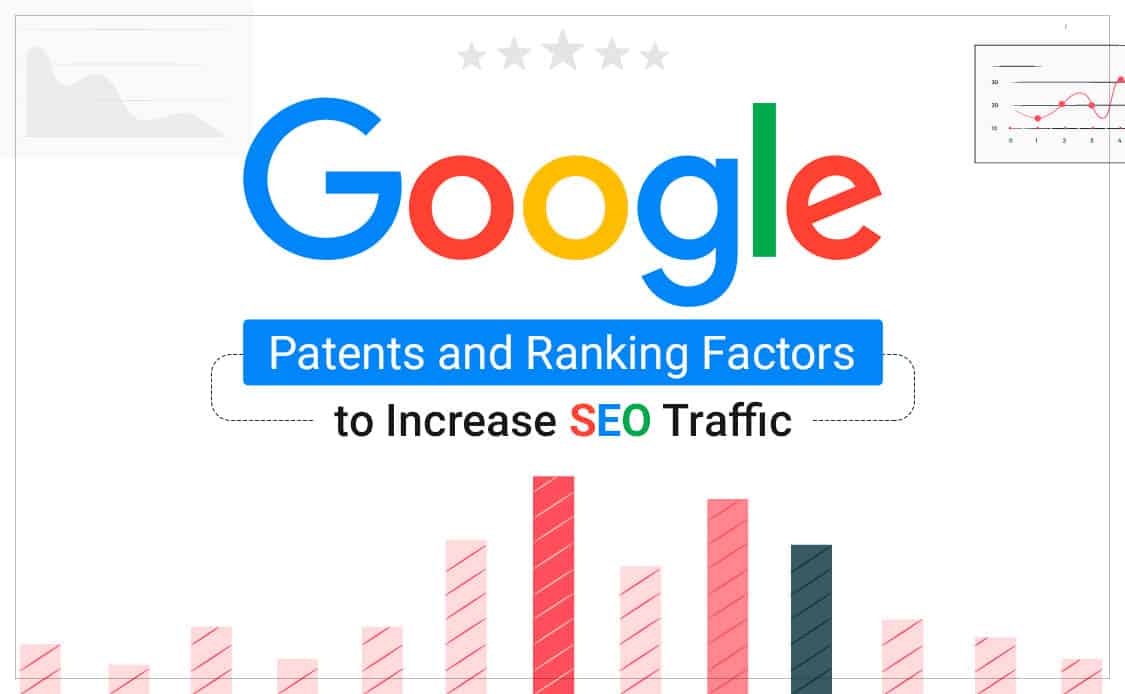Google Patents and Ranking Factors to Increase SEO Traffic

Google Search Patents are a set of patents granted to Google for their search-related inventions. They cover a wide range of topics, including ranking algorithms, user interfaces, and spam detection.
Google Search Patents can help with SEO efforts by providing information on how Google Search works and on how it can be used to improve your particular website ranking. The patents can also provide insights on how to optimize the website content to rank higher in Google search results.
Google uses a number of artificial intelligence and machine learning models, like BERT, to improve the quality of web page search results. These models help search engines to return much more relevant web pages and other responses to search queries.
Google Search Patents That Are Useful for SEO
1. Content clustering
The Google patent on enhanced text clustering based on topic clusters involves a method for improving the accuracy of text clustering by using topic clusters. The idea is to first identify the main topics in a text document and then cluster the text documents based on these flagged topics. This can be done by using a topic modeling algorithm, like LDA. Once the topic clusters are identified, the text documents can be clustered using a traditional clustering algorithm, such as K-means.
This approach can improve the accuracy of text clustering because it takes into account the relationships between topics whenever clustering documents. For example, if two documents are about the same topic, they are likely to be placed in the same cluster, even if they don’t necessarily share the same keywords. This is because the topic clusters are able to identify like information which can be used to group similar documents together.
This approach can also be used to improve the accuracy of other machine learning tasks that rely on text data, including document classification and topic classification in general.
2. Phrase-based indexing
Google’s phrase-based indexing patent describes a method for indexing phrases in an information retrieval system. The method includes receiving a query that includes a phrase, identifying the phrase, and then retrieving documents that include the phrase. Related phrases and phrase extensions are also taken into consideration. Furthermore, the method includes ranking the retrieved documents based upon the number of occurrences of the identified phrase in the flagged documents.
The phrase-based indexing patent works to improve the accuracy of search results for queries that include particular phrases. For example, if a user searches for the phrase “chocolate chip cookies,” this phrase-based indexing method can identify documents that include the phrase “chocolate chip cookies” along with other similar or related phrases. This method is helpful to ensure that the most relevant documents are returned in response to a user’s query.
3. Document scoring based on the document inception date
The Google patent on document scoring based on document inception date describes a method for determining the score of a document based on when the document was created. A score is calculated for the document, based upon the date of inception. The document’s inception date is subtracted from the current date, and then the result is multiplied by a weighted amount. The weight is a number between 0 and 1, and is based on the age of the document. Essentially, the older the document, the more weight is given to the multiplication factor.
4. Natural language search results for intent queries
The Google patent on natural language search results for intent queries explains how the search engine works to provide results for a user query that better reflects the user’s intent, in terms of the language used by the searcher. For example, if a user searches for “How do I make a cake,” the search engine may provide results that take the form of many types of relevant content, including recipes, how-to videos, and other tips on the best way to make a cake.
5. User-context-based search engine
Google’s patent on a user-context-based search engine involves a system and a method for providing search results to a user based on that user’s individual context. The method involves receiving a search query from the user, determining the context of that user, and providing results based on that user’s unique context. User context can be based on a variety of factors, including the user’s location, the user’s search history, demographic information about the user, and other information about the user’s preferences.
6. Modifying search result ranking based on implicit user feedback
Google’s patent on modifying search result ranking based on implicit user feedback covers a method for improving the quality of search results by incorporating feedback data from users’ interactions with search results. This feedback can be used to identify and promote results that are more likely to be relevant and useful to the user. The method covered by this patent describes yet another way that Google works to improve the quality of its search results by leveraging user feedback data.
7. Predicting site quality
Google’s patent on predicting site quality is based around the concept that the quality of a website can be predicted based on a number of factors, including the number of inbound links, the PageRank of the site, and the number of pages on the site.
8. Determining the quality of web pages
The Google patent on determining a quality measure for a resource is for a method for assessing the quality of a webpage or other online resource. This involves looking at factors including the page’s title, the number and quality of inbound links, the page’s content, and the page’s design. The goal is to come up with a composite number ranking that represents the overall quality of the resource. This number can then be used to compare different web pages or online resources, or to track the quality of a particular resource over time.
9. Identifying local experts for local search
Google’s patent on identifying local experts for local search covers a method and system for identifying local experts for local search. This involves receiving a search query from a user, identifying one or more local experts based on the search query, and providing the user with a list of the local experts. The local experts may be identified based on a variety of factors, including the content of the search query, the user’s location, and the user’s search history.
10. Entity-based searching with content selection
Google’s patent on entity-based searching with content selection covers a system and method for improving the search results returned for a user’s particular query. The method includes receiving a user query, identifying one or more entities based on the query, and selecting content associated with the identified entities. The selected content is then returned to the user, along with information about the entities. For example, if a user searches for “pizza,” the system may identify entities like “pizza,” “restaurant,” and “food.” The system can then select content associated with these entities, including reviews of pizza restaurants, recipes for making pizza, and articles about the history of pizza. This content is then returned to the user, along with information about the flagged entities.
Ranking Factors to Boost SEO Traffic
Ranking factors are the variables that Google and other search engines take into consideration when trying to determine where to rank a website in the search engine results pages (SERPs). There are hundreds of ranking factors, but some of the most important include:
- The quality and quantity of the website’s backlinks
- The website’s content quality and keyword relevancy
- The website’s loading speed and mobile-friendliness
- The website’s age and authority
- The website’s social media signals
Here are some other specific ranking factors that can elevate your presence on Google and other search engines
- Keyword relevance: Make sure your website content is relevant to the keywords you want to rank for.
- Keyword density: Use keywords throughout your website content, but don’t simply resort to “keyword stuffing.”
- Title tags: Optimize your title tags with keywords to help your website rank higher in search results.
- Meta descriptions: Write unique and compelling meta descriptions for each page on your website.
- Heading tags: Use proper keywords in your heading tags to give your website an SEO boost.
- Alt text: Use keywords in your alt text to make it easier for Google to index your website’s images.
- URL structure: Use keywords in your URLs to help your website rank higher in search results.
- Site map: Include a site map on your website; this will help Google to index your pages.
- Robots.txt: Use a robots.txt file to tell Google which particular pages you want to flag for indexing.
- Google Analytics: Install Google Analytics to track SEO progress for your website.
How should we optimize for better Google and SEO results?
At the end of the day, Google always favors returning the search results that are most relevant and will add the most value to the user. We hope you’ll find these insights about Google’s patents to be helpful in that regard! But perhaps you have some more questions about how to fine tune your web pages and web content for better SEO results. No problem – the pros at Cibirix Digital Marketing are here to help! Connect with one of our digital marketing experts today, and let’s get started on maximizing your digital marketing footprint!
About Author

Ashish Roy
Since founding Cibirix, Ashish has leveraged his marketing degree to lead the agency in crafting meaningful digital marketing experiences for clients. His results-driven approach is a unique mix of analytical thinking, crisp visual aesthetics and a desire to simplify frontends while developing robust architecture. With a passion for design, technology, & marketing, He leads each aspect of the agency’s business and oversees its talented team of digital professionals.











